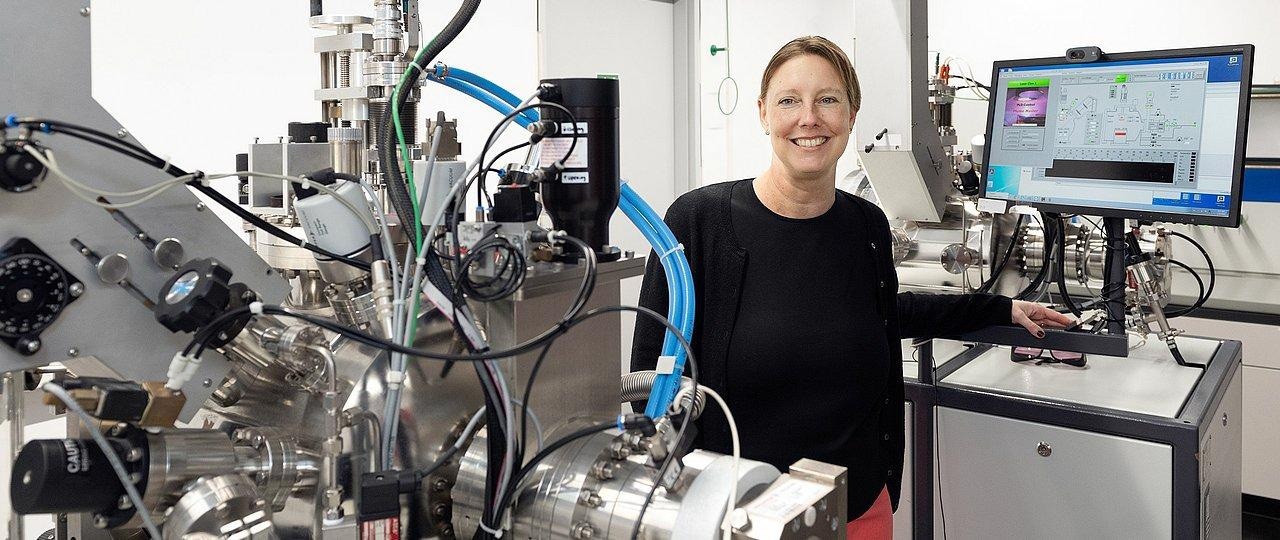Lithium-ion batteries, fuel cells and a variety of other devices rely on high ion mobility to function properly. However, there are numerous impediments to such mobility.
 Prof. Dr. Jennifer Rupp, professor for chemistry of solid electrolytes in her laboratory at the faculty of chemistry of the Technical University of Munich. Image Credit: Uli Benz/ Technical University of Munich.
Prof. Dr. Jennifer Rupp, professor for chemistry of solid electrolytes in her laboratory at the faculty of chemistry of the Technical University of Munich. Image Credit: Uli Benz/ Technical University of Munich.
Researchers headed by Jennifer L. M. Rupp of the Technical University of Munich (TUM) and Harry L. Tuller of the Massachusetts Institute of Technology (MIT) have for the first time shown that light can be used to increase the mobility of ions and improve the performance of such devices.
A charge can be transported in a variety of ways by a material. The most well-known is metals’ electrical conductivity, in which the charge is carried by electrons. Ions, on the other hand, transport the charge in many devices. Lithium-ion batteries, for example, move lithium ions during charging and discharging. Similarly, in order to conduct electricity, fuel cells rely on the transport of hydrogen and oxygen ions.
The use of ceramics as solid electrolytes for transporting oxygen ions is currently being investigated.
What we find is that the ionic conductivity—the rate at which the ions can move and, therefore, how efficient the resulting device can be—is often markedly degraded by the fact that the ions get blocked at grain boundaries.
Harry L. Tuller, Professor, Massachusetts Institute of Technology
Light Puts Ions on the Go
Tuller and his colleague Jennifer L. M. Rupp, Professor for solid-state electrolyte chemistry at the Technical University of Munich, in their study, demonstrate how light can be used to lower the barriers that ions encounter at ceramic grain boundaries.
Numerous ion conductivity-based devices, such as solid-oxide fuel cells, must operate at extremely high temperatures in order for the ions to overcome grain boundary barriers. Operating temperatures of up to 700 °C, on the other hand, present their own set of difficulties: Materials age more quickly, and the infrastructure required to maintain these high temperatures is expensive.
Our dream was to see if we could overcome the barriers using something that doesn’t require heat. Could we get the same conductivities with another tool?
Thomas Defferriere, Study Lead Author and PhD Student, Massachusetts Institute of Technology
This tool was found to be light, which was never researched earlier in this context.
Higher Efficiency Levels in Energy Conversion and Storage
Our research shows that illumination of ceramic materials for fuel cells and possibly for batteries in the future can significantly increase ion mobility. In gadolinium-doped cerium oxide, a ceramic used as a solid-state electrolyte in fuel cells, illumination increased conductivity at the grain boundaries by a factor of 3.5.
Jennifer L. M. Rupp, Professor, Solid-state Electrolyte Chemistry, Technical University of Munich
In the future, this recently found “opto-ionic effect” could have a variety of applications. It could, for example, improve the performance of solid-state electrolytes in tomorrow’s lithium-ion batteries, allowing for faster-charging speeds, or pave the way for new electrochemical storage and conversion technologies that operate at lower temperatures and achieve higher efficiency levels.
Light can also be focused accurately, allowing for the spatial control of ion flow at precisely defined points or the switch of conductivity in ceramic materials.
Journal Reference:
Defferriere, T., et al. (2022) Photo-enhanced ionic conductivity across grain boundaries in polycrystalline ceramics. Nature Materials. doi.org/10.1038/s41563-021-01181-2.